A timeline of seat belt history can be traced back nearly two centuries, but it’s only been in the past few decades that the safety feature – and its use – have become commonplace. As recently as the 1980s, only about 10% of Americans wore seat belts when riding in a car. It was an uphill battle, one that included laws, education and technological improvements, to get these life-saving devices adopted by the public.
It’s a good thing they did – seat belts have been credited with saving more than one million lives and are considered to be one of the most cost-effective public health inventions ever.
So how did seat belts go from an afterthought to a necessity? Let’s take a look.
Prefer an audio summary of this post? Click below to listen to this article.
Mid-1800s – The Seat Belt History Timeline Begins
Sir George Cayley, a wealthy landowner in Yorkshire, England, invented the first seat belt way back in the 19th century. Cayley was highly interested in aerodynamics and the principles of flight. He is credited with building the first successful manned glider, a half-century before Orville and Wilbur Wright took to the air. Inside the aircraft, Cayley included a lap belt to keep the pilot in place.
His first test flight crashed landed – the pilot survived.
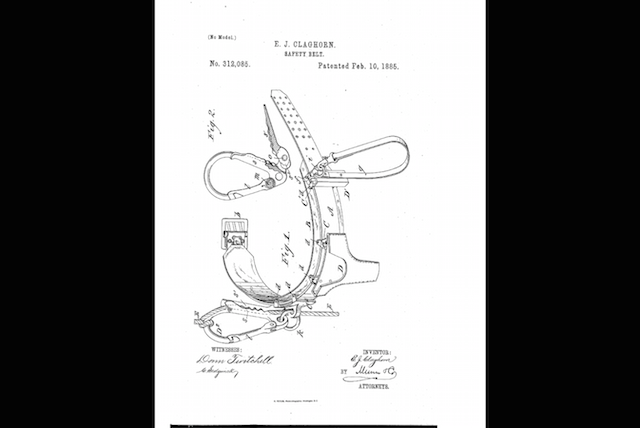
1885 – The First Seat Belt Patent Is Granted
On February 10, New York City resident Edward J. Claghorn was awarded the first U.S. patent for a vehicular seat belt. It was devised in order to keep tourists safe as they rode in taxis. The seat belt looked more like a present-day climbing harness, consisting of a strap that used hooks to secure a rider to the seat.
1922 – The Seat Belt Comes to the Indy 500
Barney Oldfield, a racing pioneer and the first person to drive 60 mph, recruits a parachute manufacturer to design a restraining harness for his Indy 500 car. Oldfield had seen several drivers get hurt, and even die, after being ejected from their vehicles.
Prior to this (and in the decades following) seat belts were rarely worn. One myth that prevailed during this time was that it was safer to be flung from the car than remain inside the vehicle as it crashed and potentially burned. Manufacturers, meanwhile, believed that if they included too many safety features, it would give consumers the impression the car was unsafe.
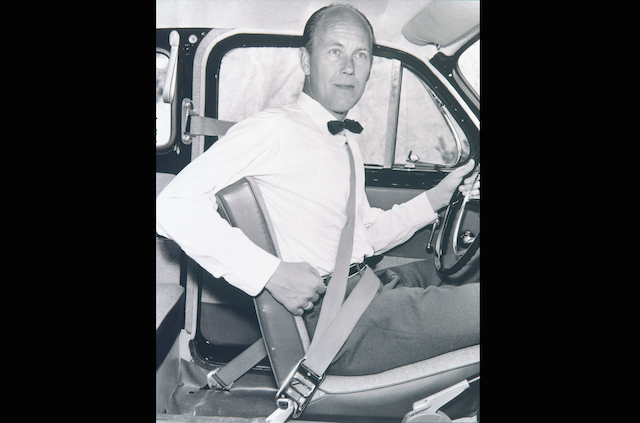
1959 – The Three-Point Seat Belt Is Invented
The most important evolutionary step in seat belt history timeline occurred in 1959 when Swedish engineer Nils Bohlin invented the three-point seat belt. Volvo Car Corporation hired Bohlin the year prior as the company’s first chief safety engineer. He had previously worked designing ejector seats for fighter airplanes.
Two-point seat belts only secured the passenger’s lap (and were hardly ever worn at the time). The four-point belts Bohlin was used to in airplanes were untenable in cars. His solution was a three-point seat belt that used one continuous belt. One section ran diagonally across the body while another section crossed the lap, creating a restraint for both the upper and lower body.
The first car to feature the three-point seat belt was the Volvo PV544, but it was quickly joined by others. Maybe the most remarkable – and most significant – aspect of this invention is what Volvo did with their new technology: they gave it away for free. The company allowed other manufacturers to have the design free of cost, all in the name of safety. At the time of his death in 2002, Volvo estimated that Bohlin’s invention had saved more than one million lives in just four decades.
1961 – Wisconsin Becomes First State to Require Seat Belts
On September 25, Wisconsin became the first state to require seat belts be installed in the front seats of all new cars. This law only required cars to have seat belts. There was no such rule that passengers had to wear them.
1968 – Seat Belts Become Nationally Mandated
The first federal law mandating all new cars be equipped with both lap and shoulder belts in the front seat is introduced. Although the three-point seat belt had been around for nearly a decade, the law did not specify the need for any particular design. As a result, many automakers installed separate lap and shoulder belts.
1973 – The Seat Belt Interlock Mechanism Is Introduced
The 1970s and 80s were the most tumultuous stretch of time in in seat belt history. It all began in 1973, when the National Highway Traffic Safety Administration required all new cars to install a seat belt interlock mechanism. The inexpensive device prevented a car from starting until the driver’s seat belt was buckled.
The public had issue with this, feeling the government was overreaching with an intrusive mandate. Automakers, meanwhile, weren’t keen on adding to their costs. Congress responded by nixing the law the following year.
1983 – Seat Belts Reach the Supreme Court
It’s a strange but true fact that more than one automobile feature has been at the center of Supreme Court cases. This includes the humble seat belt.
The backstory to the case began in 1977. After the interlock mechanism law was denied, the NHTSA came back with rule stating carmakers must include some sort of passive restraint that worked automatically without driver intervention and protect passengers when hitting a wall at 35 mph.
It seemed all but certain that automakers would be made to include seat belts in their vehicles – and then the 1980 presidential election turned things upside down. Ronald Reagan ran his campaign around deregulation. Naturally, when he took office, he opposed a law that forced the manufacturers to do something against their will. The requirement was thus revoked.
But there was a second industry in play. Insurance companies, which had a vested interest in the safety of passengers, sued the administration. The Supreme Court ruled unanimously in favor of the insurers and ordered the Department of Transportation to reinstate the requirement.
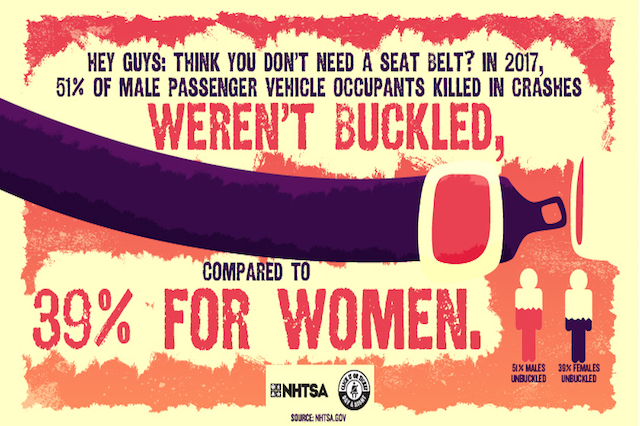
1984 – New York Requires Front-Seat Riders to Wear Seat Belts
New York became the first state to require the use of seat belts. The bill, which went into effect Jan. 1, 1985, only mandated front-seat passengers wear seat belts. If they did not comply, they faced a fine of $50. Now it is also required by law for passengers 16 and older to wear a seat belt in the back seat.
Today, nationwide use of seat belts is approximately 92%. New Hampshire is the only state that does not require adults to wear a seat belt. Roughly 15,000 lives are saved by the safety feature every year in the United States, according to the NHTSA.
For more on automotive safety, visit AAA.com.
43 Thoughts on “A Seat Belt History Timeline”
Leave A Comment
Comments are subject to moderation and may or may not be published at the editor’s discretion. Only comments that are relevant to the article and add value to the Your AAA community will be considered. Comments may be edited for clarity and length.



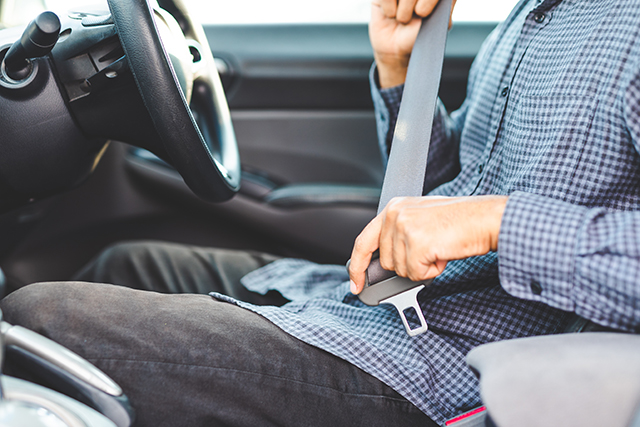









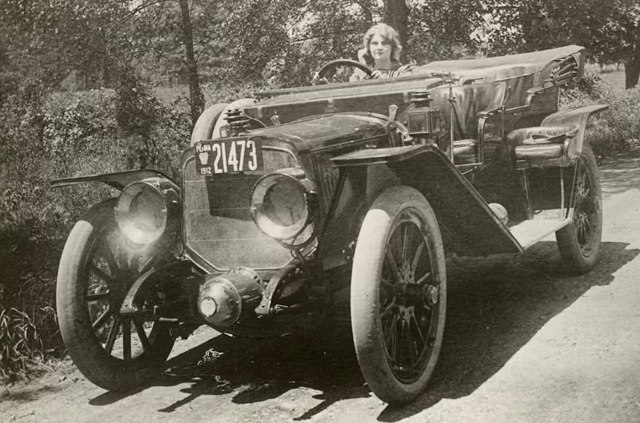


Is there a car with a seat belt that won’t hit a 5 foot driver in the neck?
My wife, our 2 children had finished a ski day in Vermont when a winter storm started as we left in our Ford Explorer to descend to the main road back home; the car went out of control and flipped on it’s side in a ditch on the way down; all 4 of us had seats belts on and it SAVED ALL OUR LIVES!!!!! We are all true believers in the need for seat belts in cars!!!!! 😀
Sorry,
This article fails to mention that the City of Brooklyn, Ohio was the first City in the World to institute the Seat Belt Law, under the urging of Mayor John M Coyne, the longest serving Mayor of a City in the United States having served for (52) consecutive years. Not his fault the State of Ohio dragged their feet but give the guy his due – He is the one to first come up with the idea and implement a now International Law.
I cannot help but think that the same people who refuse to wear seat belts are the same people who refuse to take COVID-19 shots as they are an imposition on personal freedom. Yet we live in a society where personal freedom has never been absolute since absolute freedom results in all sorts of things that can harm others! It is true, I believe, that insurance companies pressured legislators and other influencers to require seatbelts and that may well have been to keep their own costs down and increase profits, and not necessarily for altruistic passenger safety concerns. Nevertheless, drivers and passengers DO benefit from better survival rates and fewer injuries.
two memories: My dad would never buy a car with four doors–before seat belts–because he had heard and seen too many instances of children opening the rear doors and being injured.
A second memory: when I bought a vw bug in 1963-64 (NJ) it had anchor connectors for seat belts but no seat belts. A local civic group was installing seat belts free but they did not fit into the anchor positions. So the way they dealt with that problem was to take a big spike an create a new position to anchor the belt. I declined the installation but took the belt and purchased an adaptor that connected the belts safely. We also bought a harness for our very you son for the back seat. I’m sure it wasn’t as safe as a belt and in fact may have very dangerous but it did keep him in the car and gave him some room to stretch out and sleep.
Does any one know what year the break away rear view mirrors became mandatory?
I started using car seatbelts in the late 60’s / early 70’s because as a USAF pilot, harnessing into the aircraft ejection seat was a must, so I figured seatbelts in my car would help save me in case of a car crash.
In the late 60’s when we finally got a car with seat belts installed my father made me promise to always use it.
As he got older I did have to nag him to use his – and frequently remind him of the promise he asked of me!